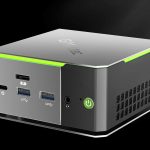Recently, One-Netbook, the parent company of the Onexplayer AMD 5800U Mini gaming system (review here), contacted me to ask if I would like to try their A1 Pro mini laptop. This laptop offers IT professionals an RS-232 port, Ethernet port, and VESA mounts so that the system can be integrated and connected to various devices. However, researching the product for review, including unboxing the system for the first time, I was confused about the direction the company has headed with the product since its initial release. The company did provide me with an updated press release, which I have looked through to see if it would help to clarify some of my findings about the One-Netbook A1 Pro.
One-Netbook A1 Pro: Better Left in the Hands of Professionals?
This product is not sold on their One-Netbook site but sold on the gaming sub-brand Onexplayer website for $920 (currently on sale from $1,079). For English audiences, the previous generation A1 was focused on IT engineers, allowing them to work more efficiently when mobile, with the power of a system that could debug and more, while twisting its screen 180 degrees for the use of the integrated touch screen, so you can draw schematics and more during meetings or while sitting on the couch.
In my further research, I found this YouTube video from the company for the previous generation, the One-Netbook A1:
Upon looking at the One-Netbook A1 site, this sticks out on the product page for the device. Please keep in mind this is on the A1 and not the A1 Pro website.
“It’s a compact PC that’s ideal for busy businessmen, engineers, and creators because it can be carried anywhere.”
Both products, outside of updated components, look reasonably identical. So, I did further research on the A1 Pro because the product seems to offer more than just an engineering tool.
I have watched a few reviews on YouTube and read a few on the Internet, and most of those reviews, test the gaming possibilities. And why not? We now live in a society where gaming on the go is becoming the norm. Companies such as Onexplayer, Valve, AYANEO, GKD, and AOKZOE have entered the handheld gaming PC market and have made a niche for each.
One-Netbook wants its users to use the new A1 Pro for work, but they also want a stab at the gamers out there, and with some aesthetic choices on the device, it is very apparent.
Design and Features
Let’s take a closer look at what I am talking about and product specifications before benchmarking and testing the product in real-world gaming situations.
The specifications of the One-Netbook A1 Pro system are as follows:
Intel i5-1130G7 CPU (11th Gen Core “Tiger Lake” processor)
four cores across eight threads
Intel Iris Xe Graphics (integrated)
LPDDR4X high-frequency memory
PCIe NVMe Micro SSD
1920 x 1200 resolution
323 PPI pixel density
5800Rpm fan with vacuum liquid and copper pipe cooling system
For port connections, the One-Netbook A1 Pro offers:
RS-232 serial port and RJ45 Ethernet port
3.5mm audio port
Micro HDMI
two USB 3.0
USB-C 4.0 for charging
TF slot for micro SD cards
First, the size of the One-Netbook A1 Pro is 173x136x19mm. The width and length are similar to the dimensions of a Kindle Paperwhite but much thicker. I can quickly grasp it in my hands, whether holding it like a tablet or like a closed hardcover book. The tilt and swivel of the screen are considered a Yoga-style design, coined from Lenovo and their aptly named line of notebooks. The screen swivels to the left 180°, but not to the right. I appreciate the company choosing only one direction for the monitor to swivel to keep the screen from being over-rotated and becoming more fragile through repeated use.
2 of 9
The keyboard has 69 keys, not counting the power button above the keys. This is where the noticeable focus changes through design. Outside of the atypical QWERTY keys, every button has two to three uses, whether you are activating the secondary or tertiary option via the SHIFT or Function (Fn) keys. Volume levels, backlit keyboard control, internal fan control, and more are available through various keystrokes.
The hardest adoption I found when using the One-Netbook A1 Pro is trying to find where different punctuation keys have been moved. I occasionally adjusted volume settings or the keyboard backlight, but I left most extra functions alone outside of that. As a “writer,” I tend to depend on the additional thirty-eight keys on full-size keyboards.
The number pad, for example, is a section of a regular keyboard that I have adapted and used frequently. Home, End, Pg Up, and Down buttons were other keys I became accustomed to through everyday use. With the One-Netbook A1 Pro, this was much more difficult, if not incapable of replacing my standard mechanical keyboard or older laptop. However, that is not to say that I could not replace my system and laptop for several days.
2 of 9
Another noticeable difference in keyboard design is when you glance at the keys on the left compared to the right. The left quadrant of keys is more prominent, which could be due to a design choice when most games utilize the W, A, S, and D buttons, which have a design element I will discuss later. On the right side of the One-Netbook A1 Pro, the keys become smaller and squished together. Using the arrow buttons was practically a chore since the keys were so minor.
2 of 9
One feature that One-Netbook has chosen that (I assume) could cater to a gaming market space is the choice to put an individual box around the letters W, A, S, and D, to highlight them on the keyboard for easy accessibility for users to find. It is almost as though the developers felt that they needed to highlight those keys in the hectic keyboard environment.
I spent one week attempting to primarily use the One-Netbook A1 Pro as my primary system and tried to use it as if I was only using a single monitor on my primary system in a Windows 11 environment. I was able to have four windows open in all four quadrants of the 7-inch screen, and the system, outside of sounding like the fan was going to cause the notebook to take off from my desk, and watch Twitch, work on a document, edit a graphic, and browse the Internet without any significant slowdown. Is it ideal for someone in their mid-40s to use it as a complete system? Not without adjusting for eyesight and other viewing factors since the screen is smaller than full-size notebooks.
One of the strains of using the One-Netbook A1 Pro was remembering where buttons or punctuation marks had been moved on the keyboard. There were plenty of times that I would struggle to find the question mark or quotation mark buttons on the keypad.
The Yoga-inspired design allowed me to read my books on Kindle, but compared to my Kindle Paperwhite and various Fire Tablets, this system was heavy and uncomfortable in my hand for long periods. Also, using it outside was difficult as the screen’s brightness could not be bright enough to see in direct sunlight. I tended to put the laptop in my lap and watch YouTube, Twitch, or Netflix while on the couch or lounging in a chair.
Image source: J. Wilson, Wccftech.
The trackpad, while minute and very responsive, was just too small for my hands. I grabbed the smallest Logitech wireless mouse I could find and continued to use the system as I would any other, leaving one USB port available for me to connect another wireless dongle device or connect a wired controller to the device.
Testing
3DMark Time Spy
3DMark Time Spy is created to calculate the gaming performance of a Windows computer system. The utility allows us also to view the processor’s performance.
One-Netbook A1 Pro
PCMark 10
PCMark 10 is a comprehensive benchmarking tool for Windows 11 systems. The PCMark 10 tool offers exhaustive Windows PC performance testing for everyday home and business use, including workloads for basic computing, storage, image, video manipulation, web browsing, and gaming. The benchmark tests are designed to be tested on everything from power-hungry PC systems to laptops to microcomputer systems, such as the One-Netbook A1 Pro.
One-Netbook A1 Pro
Cinebench R20
Cinebench Release 20 (R20) offers a real-world cross-platform test suite that assesses the abilities of the system’s hardware. Over the last few years, the suite has been updated to provide more support for newer processor and imaging render technology, supplying an exact measurement of Cinema 4D’s capability to utilize multiple CPU cores and current CPU features that are obtainable to most users.
One-Netbook A1 Pro
CPU-Z
CPU-Z collects data from your system, such as the CPU name and number, series codename, process, package, cache levels, mainboard and chipset, memory type, size, timings, module specifications (SPD), and real-time measurement of each core’s internal frequency and memory frequency.
One-Netbook A1 Pro
Geekbench 5
Geekbench 5 allows users to measure the system’s CPU power.
One-Netbook A1 Pro
Gaming Benchmarks
One-Netbook A1 Pro
Gaming, not surprisingly, is rough on the One-Netbook A1 Pro, which is not all that surprising due to the technology powering the system and graphics. The mini notebook is much more suited towards low FPS and casual games. Casual games will see a good home on this system as well. I have seen some emulators run on the system, which can be fun to tinker with and revisit old games but takes out the enjoyment of using the actual consoles in place of the One-Netbook A1 Pro.
I struggled more to find games to benchmark on the system. Out of the ones that I benchmarked, there were two to three times as many games that I could not test. I tried to find games closer to what we see currently, so I was being much more selective in my choices.
Afterthoughts
Can the One-Netbook A1 Pro be a gaming device? Yeah, it can, but it needs assistance to do so.
First, there are several great games made by independent game developers that are a joy to play. Below is a selection of titles that were great choices of games. Most found are low-priced but well-liked or rated above “Positive” among most gamers on Steam:
Rising Hell
Darkwood
Slain: Back From Hell
Horace
Scourge Bringer
The Binding of Isaac
Slay the Spire
Unpacking
Undertale
Many of these are neo-retro style games, meant to harken back to a 16- to 32-bit era. Some are simple in style, low in file size, and would be easy to play on this mini notebook. For instance, one of my favorite titles, Disco Elysium, plays beautifully on this system and even better with headphones. But it doesn’t have a ton going on the screen and is expected to play nicely on several devices. The only issue is the text was much smaller, so for games with a lot of text, this may not be the right system for you.
Cloud gaming was quite a surprise. I have an Xbox Series S, and I thought I would try the cloud gaming service offered by Microsoft. I tried a handful of titles — the new title Scorn, Microsoft’s Flight Simulator, Forza 5, and Far Cry New Dawn. Far Cry New Dawn was incompatible with standard tests, but the game loaded with zero problems and the graphics were stunning when played via the cloud. All the games did well, showing how far we have come in cloud computing and gaming to pull off such a task that initially would not have been available less than a decade ago. It was like I had my Xbox in the room with the smallest screen I could find, next to my iPhone 12 Mini.
This means “yes,” this system can play games. But you have to be selective with your choices when playing natively and when playing on the cloud. Batteries will be highly recommended, while if you are at home, attaching it to the AC adapter would be wise on the user’s part. The battery lasts up to six hours but depends on use, meaning if you game on it, the battery will plummet in power, but small tasks will last the total rate. Also, make sure to have a controller at the ready. The keys on the keyboard on the left side are spaced adequately, but as you move toward the right of the keyboard, everything is squished together. Games that require arrow keys will be challenging for large hands. Mice and keyboard combinations would fair well instead of using the minute trackpad, regardless of responsiveness.
Returning to the discussion of using the system as a replacement for my primary system after one week. I went from an initial typing speed of 31 WPM. Still, after using it for several hours each day, it improved to an average of 40 WPM (via the website 10fastfingers.com, where I occasionally test my typing speeds, which is, on average, 53 WPM). I edited documents, did content creation through the online site Canva (which has a huge user base), watched Twitch streamers, kept in contact on Discord with friends, listened to Spotify, read Dr. Jekyll and Mr. Hyde on the Kindle website, checked my mail, and other daily tasks. I would never dream of streaming from the device, as it is nowhere near compatible with attempting to play any AAA games from the last six to eight years or anything that would push the system to the brink. It just cannot handle something a current laptop can. It was rated lower than any current laptop in the 3DMark TimeSpy results. But that does not mean there is no market for the One-Netbook A1 Pro.
I read of several businesses that use devices equipped with the RS-232 port on the back of the A1 Pro, but most enterprises would be buying such a device in bulk. This bulk purchasing benefits businesses as they would most likely receive a discount from purchasing directly from the manufacturer.
Conclusion
Is the market for a device so niche that some may look elsewhere for a product suited for handheld gaming or everyday use? That is up to you, the reader, to decide. With slightly low-powered technology, physically small size, confusing keyboard layout, high price tag, and normal battery life that you would find in something this small, the high cost may be the breaking point in a solid purchase of this device.
The post The One-Netbook A1 Pro Review: A Notebook & Handheld Console Combo? by Jason R. Wilson appeared first on Wccftech.







